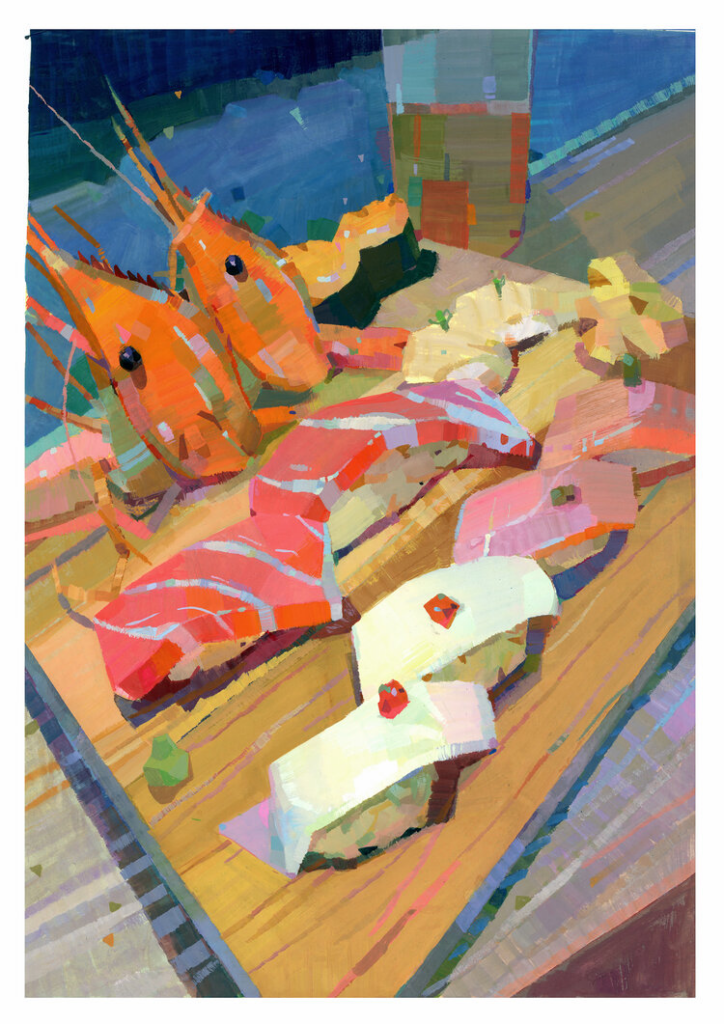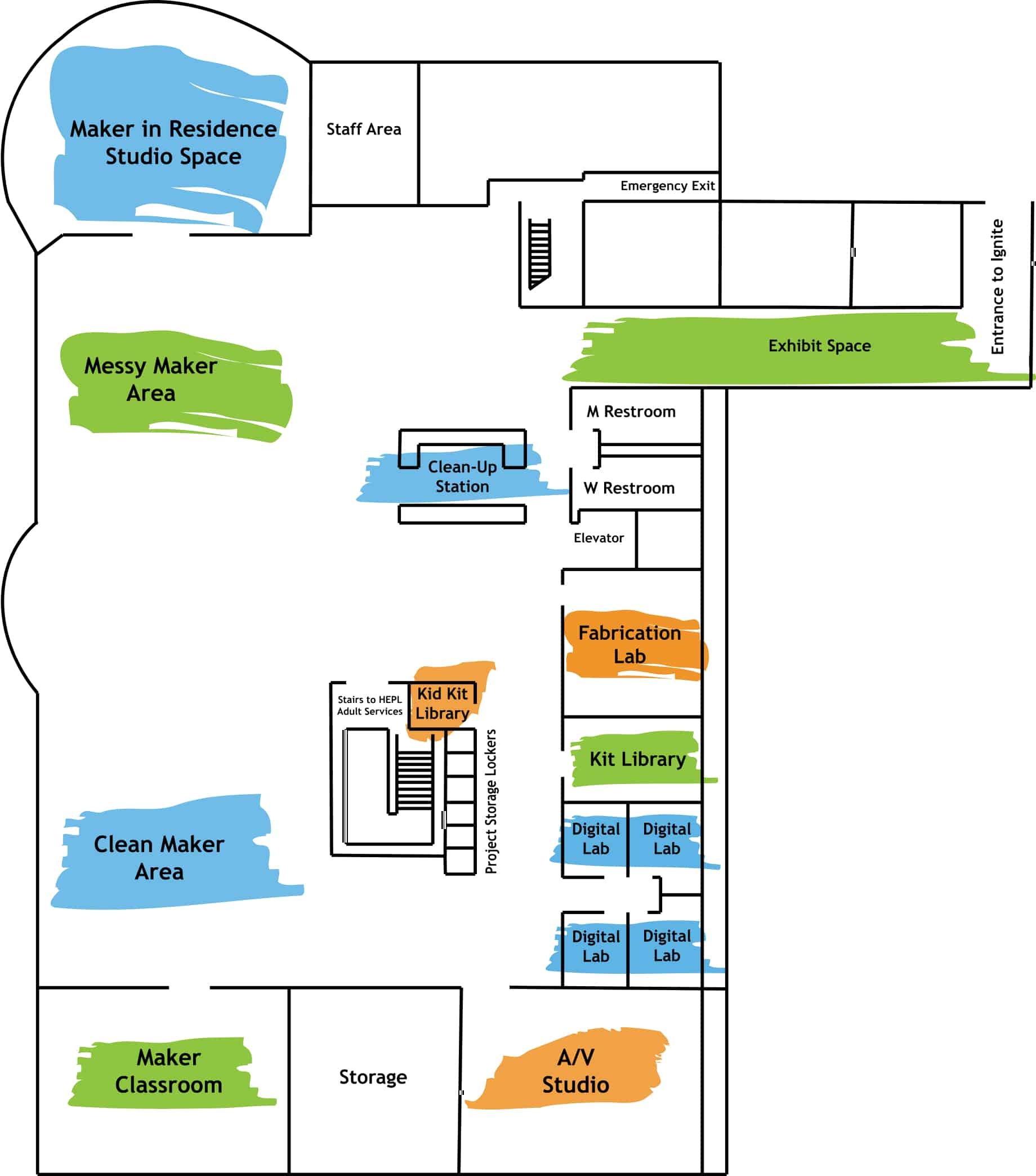By Sydney Brink
What’s up with paint? There’s so many different types of paint out there it can be overwhelming figuring out where to start. Here’s a breakdown of what you need to know before trying out a new media.
What’s Up with Oil Paint?

The Milkmaid, Johannes Vermeer, 1658-1660
Oil paint is an opaque medium made of pigment suspended in linseed oil. It’s slow-drying and thick, and can be found in tubes or cans of various sizes.
Tools:
You should use natural hair brushes, typically something very stiff like boar or hog hair. Palette knives are also suitable for laying down paint. You can work on a primed canvas or specialty paper made for oil painting, but it has to be either primed or specialty paper because the oils will eat through canvas cloth and paper over time.
Working:
Oil paint is thick. You’ll need chemical solvents like mineral spirits to thin the paint to a consistency you can actually use. You can blend colors directly into one another (referred to as a “wet-on-wet” technique) or apply paint in glazes (which are thin washes of color layered on top of each other). You can also work on projects long-term, making it a good medium for large works of art that will take a long time to finish.
Finishing:
Oil paint takes an extremely long time to dry. Certain colors and thicknesses can take up to a year to dry! Keep this in mind when you’re painting with a due date. Oil paints usually finish satin, but you can use mixing mediums to give your painting a different finish.
Cleanup:
Oil painting requires some special solvents and soaps to clean up after, some of which are toxic for both you and the environment. You’ll need to wash your brushes after every use, and it’s often more convenient to let your paint palette dry and then scrape the dried paint off, rather than clean it each time. But be careful; those paint chips are likely toxic too!
Price: $$$-$$$$.
Oil painting requires brushes, already primed canvases* or expensive specialty paper, mixing mediums like linseed oil, and cleanup supplies like turpentine or mineral spirits. This is not to mention even the paints themselves – 150 mL tubes of paint can be around $25, and paint colors made from expensive pigments like those made from cobalt or cadmium can be well over $50.
*Of course you can make your own canvases for cheaper – but budget in lumber, canvas cloth, sizing glue, gesso, and the time and resources you’ll need to make them.
What’s Up with Acrylic Paint?

The Splash, David Hockney, 1966
Acrylic paint is an opaque paint that has a lot of components in it, the most common of which are pigment and an acrylic resin binder. It dries quickly and has a lot of versatile uses, from painting to printmaking. And it can be found in tubes of various sizes.
Tools:
Synthetic nylon hair brushes work best for acrylic paint: they’ll fray less over time so they keep their shape and they hold less water than natural hair brushes. You can use acrylic paint on lots of different surfaces, the most common being mixed media paper or canvas.
Working:
Acrylic paint dries extremely quickly. Keep this in mind when working on large projects – you could put a brush down and be left with a brick of unusable paint only 20 minutes later. This applies to paint on your palette too! Acrylic doesn’t leave a lot of time for musing over a painting. Also, the paint that dries cannot be reactivated (not even to be removed with soap and water). You can apply the paint in glazes or just in brushstrokes of opaque paint. However, the quick drying discourages wet-on-wet techniques and blending color directly on your working surfaces. Acrylic also requires a mixing medium before you can use it: either water or another additive. Mixing media for acrylic comes in a wide variety of options: slow-drying, matte, thinning, thickening, and crackling are just a few!
Finishing:
Acrylic paint can have a variety of finishes depending on which mixing media you work with. Just using water and paint will give the painting a shiny, plastic-looking finish. Since acrylic is very flexible when it dries, your painting is much less prone to cracking or breaking than dried oil paint.
Cleanup:
Cleaning acrylic paint is time-sensitive but simple: just soap and water for brushes and palettes alike!
Price: $-$$.
You can buy either student-grade or artist-grade acrylic paints depending on your project and price constraints. You’ll also need brushes, your painting surface of choice, palettes, and, if you’d like to change how the acrylic paint looks and feels, a mixing medium to manipulate the paint.
What’s Up With Watercolor Paint?

Venetian Canal, John Singer Sargent, 1913
Watercolor is a transparent medium made of a pigment, gum arabic and some kind of water-soluble component. It can be portable and is easy to start using. Lastly, it can be found in tubes or in pans as cakes.
Tools:
You’ll want natural hair brushes for watercolor – the most prized is sable hair. You can use any soft, natural brushes though: natural hair brushes pick up and hold lots of water, which is exactly what watercolor calls for! Watercolor is almost always done on specialty watercolor paper, which is either entirely or partially made from cotton fibers for more water absorbency. Without watercolor paper, your artwork will curl. You can get cold-pressed paper, which is the most common watercolor paper and has a nice tooth and absorbs water well. Or you can get hot-pressed paper, which has less texture and absorbency but allows manipulation of the paint for a little longer before the water evaporates.
Working:
Watercolor is easy to use but difficult to master. It can be finicky and delicate, and extremely unforgiving to mistakes. The transparency of the paint means no corrections or painting over. Watercolor is best applied in glazes, but a variety of techniques are explained in this video to help you learn how to get started! It’s good to note that your painting can always be rewetted to work on during long term projects. Watercolor can be time-intensive as you wait between layers for paint to dry or if you’re working slow for detailed work, so being able to reactivate your painting as you go can be helpful.
Finish:
Watercolor has a matte finish and dries just as quickly as the water evaporates from the paper. Your watercolor paintings might look more vibrant than paintings in other media because of the composition of the paint itself. The water evaporates away and the gum arabic absorbs into the paper, so only your pigment is left on the surface making it seem more saturated.
Cleanup:
Cleanup for watercolors is easy and quick. Just rinse out your brushes in clean water and, if you’re using dried watercolors, pat your cakes dry so no mold develops in your palette.
Price: $-$$$$.
Watercolor can be shaped to fit many different budgets! You can buy student or artist grade paints in a variety of formats, from pre-made travel palettes to tubes of individual colors. You can spend your budget on expensive sable brushes that can be hundreds of dollars for a single brush. Or you can grab some squirrel or goat hair brushes for a more cost-effective tool. If you’re practicing art cruelty-free, synthetic brushes have come a long way in recent years – just make sure it’s soft and absorbent! Watercolor paper also comes in a variety of qualities, from student packs to artisanal sheets.
SIDE NOTE: TEMPERA
Tempera is a paint that has a composition similar to watercolor. Tempera today is a mix of rough-ground pigments, a water-soluble solution and a binder. Historically, this binder was egg whites, which is why you may see tempera referred to as “egg tempera”. Today, the difference between modern tempera and watercolors is often the price tag. Tempera is much, much cheaper. Since it’s cheap and water soluble like watercolor, tempera is often the paint of choice for doing projects with kids. If you’ve ever used Ignite’s kid’s kit for painting and color mixing, you’ve used tempera paints!
What’s Up with Gouche Paint?

Taiwanese Sushi, Angela Sung, 2021
Gouache (pronounced like gwash) is an opaque to transparent media made mainly of pigment and gum arabic. Gouache has a makeup similar to watercolor, but performs much differently. You can find gouache in pots or tubes, and certain types of gouache can be used as dried cakes in pans.
Tools:
Gouache is made similarly to watercolors, but with more gum arabic and less water-soluble binders. The pitfall you might fall into here is using watercolor brushes, which hold a lot of water, and accidentally waterlogging your paints. While you do need water to thin gouache, it needs about the same amount of water as acrylic paint. Synthetic brushes made for acrylic paint are best. Your paint will behave better with the stiffer bristles anyway. You can paint gouache on many surfaces, the most common being mixed media paper or watercolor paper. Like watercolor, gouache might have a hard time on canvas.
Working:
Gouache is notoriously mystifying to some. It’s a little like working with all three other popular paint types and uses techniques from across the board. Gouache needs just a little bit of water to be activated. It shouldn’t be sitting in liquid, but does need enough that you get a smooth brushstroke. Gouache can be reactivated with water, meaning you can practice “lifting” (removing dried color with water) and other watercolor techniques. Gouache can be used wet-on-wet, in glazes, or can be applied like acrylic and oil paint with thick, opaque brushstrokes.
Finish:
Gouache tends to dry differently than other paints. Lighter colors dry to be darker, and dark color dry to be lighter than how the paint looked wet. This makes it difficult to color match, and your finished project might look a little different than you intended because of this. Gouache dries matte, but you can buy specialty gouaches with a satin finish.
Cleanup:
Gouache cleanup is easy. Like watercolors, just rinse out your brushes. Since gouache can be reactivated with water, it’s okay to leave your paint palette out to dry without rinsing it off. A spray bottle with water can help you reactivate your palette when you’re ready to paint again.
Price: $-$$.
Gouache paints themselves can be found cheaply, although they show up less frequently in art supply stores- you might have to find an online seller. You can also find more slightly expensive, artisanal gouaches, like paint made especially for artists in places like Japan who paint using calligraphy style brushes on rice paper. You’ll need brushes and paper, too. I’ve been enjoying painting on black mixed media paper. The gouache is opaque and vibrant enough to pop on black!
If you’re hoping to try a new type of painting without the cost, come to Ignite to try out watercolor or acrylic paint kits! I also encourage you to go forth and learn about these paints on the Creativebug database, which you can access using your HEPL library card, or invest some time on YouTube learning from fellow artists. Happy making!


